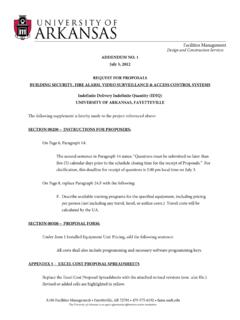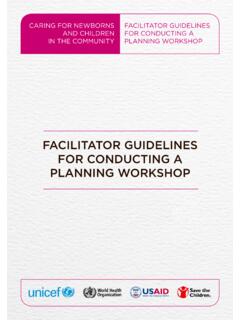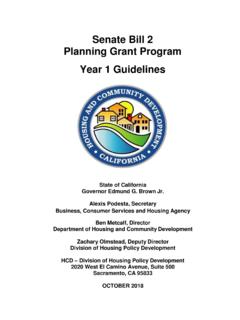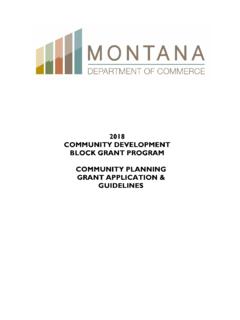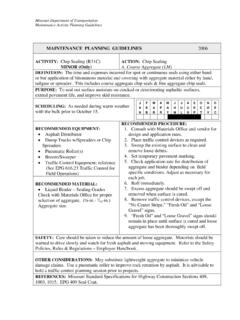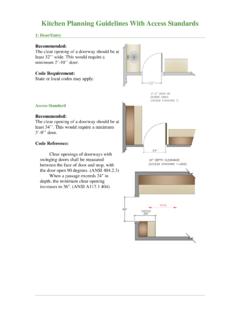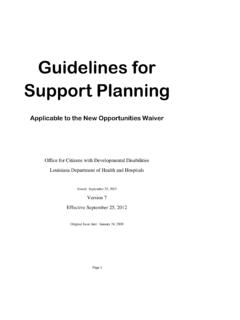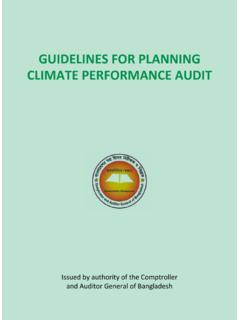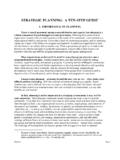Transcription of Planning guidelines
1 01. 07. 2 0 0 8 University of ArkAnsAsfAcilities MAnAgeMentPlanning - criteria for landscape - criteria for siting new facilities - criteria for architectural - criteria for historic - criteria for campus - criteria for sustainabilitysee also:Campus Furnishings StandardsCampus Landscape Standards201. 07. 2 0 0 8 University of ArkAnsAsfAcilities MAnAgeMentPlanning CRiTeRia FOR landsCaPe designThe landscape of the UA campus is predominantly one of trees and lawn. In this, it follows a long collegiate tradition stretching back to Oxford and Cambridge of simple, well-deliniated outdoor spaces shaded by spreading canopy trees. The following guidelines seek to reinforce and extend this collegiate tradition by discouraging excessive complexity of landscape forms and materials, promoting a unified campus landscape rather than a collection of individual landscape projects, and creating consistency of hardscape materials and details, along with outdoor PLANTING A campus is a place for trees and grass, nothing more.
2 Beatrix FarrandIn general, the campus landscape should be bold and simple: large canopy trees, lawn, and low ground covers. When appropriate, large, woody shrubs and/or ornamental trees should be used to emphasize the architectural characteristics of the building entrances, fa ade articulations, corners, etc. Key guidelines :Landscape typology - in order to clarify design intent for both spatial effect and function plantings should be conceived of in typological terms: all e, bosquet, grove, lawn, garden, park, fountain, pool, embankment, terrace, court, meadow, etc. Vague and undescriptive terminology should be avoided: water feature vs fountain or green space vs of open spaces - planting and building arrangement should reinforce and clarify the relative importance of campus to define space - in large spaces, structural tree planting should be used to define or reinforce the perimeter of the space, emphasize gateways, create all es, around buildings - general foundation planting should be avoided.
3 Plantings at building edges should only be used to emphasize and enhance the character of the 07. 2 0 0 8 University of ArkAnsAsfAcilities MAnAgeMentPlanning guidelines10 Planting scale - the size of outdoor spaces should determine the scale of the planting. Large spaces, such as quadrangles, should include larger tree species, while small spaces, such as a passage between buildings, can include small trees and/or plantings - plant material should be used, when appropriate, as an alternative to architectural means for solving functional needs like providing enclosure for outdoor activities, concealing loading docks, service areas, and parking lots, and controlling pedestrian movement and plantings - highly-decorative or figural plantings should be avoided except when called for explicitly in the Campus and augmentation of the native flora is encouraged in those areas of campus where mature vegetation stands remain such as the Oak Ridge Trail and other forested hillsides.
4 In addition, when choosing plant material for a project, the designer should always take care that no invasive species are HARDSCAPEThe design of any new hardscape at the UA campus should strive for two goals: to limit, as much as possible, the amount of paved surfaces necessary for the project; and, to seamlessly blend the hardscape with the campus as a whole, avoiding the appearance of a discreet project. Similarly, the language of the hardscape design should be seen as distinct from the building itself, not extending any motif from the building into the larger campus landscape. In order to facilitate these goals, the following diagram of pavement hierarchies illustrates the several acceptable pavement types and their uses on the UA campus:dO nOT PlanT:Acer saccharinum - silver mapleAlbizia julibrissin - mimosahollies:ilex cornuta rotunda - dwarf hornedilex vomitoria nana - dwarf yauponilex cornuta - chineseilex vomitoria - yauponJuniperus - juniper: all varietiesligustrum lucidum - tall glossy privetMalus hybrida - flowering crab applepines:Pinus mugo compacta - mugoPinus nigra - austrianPinus sylvestris - scotchPinus thunbergii - japanese blackPyrus calleryana - callery pear.
5 All varietiesyucca filamentosa - yuccaPyrus calleryana Bradford 01. 07. 2 0 0 8 University of ArkAnsAsfAcilities MAnAgeMentPlanning guidelines11 The design of hardscape directly adjoining the project entry areas, etc is part of the designer s basic services. The materials must be selected from the Campus Landscape Standards or, when another material is deemed necessary, directly complement that material palette. see campus landscape standardsKey guidelines :Minimizing concrete surfaces - for large areas of paving such as plazas, terraces, etc. concrete should be avoided. Excessive brightness and glare, tendency to crack and degrade, and the inappropriately large scale of unbroken paved surfaces are all aesthetic reasons why concrete is not desirable for these applications.
6 Pavers should be used instead. No stamped concrete or simulated pavers. Minimizing impervious paving - both new projects and major renovations should be seen as an opportunity to replace existing impervious paving with landscaping or with new pervious paving/re-charge beds. Pavers set in sand, crushed stone, and grasspave are three solutions which allow varying levels of water to penetrate the surface. 1. SPECIAL PAVING AREAS2 . S E N I O R WAL KS3. ENTRY PAVEMENTS4. SECONDARY WALKS5. CRUSHED STONE important campus spaces and pathwaysmaterials: stone/brick/asphalt pavers walkmater ials: c o ncrete w i t h s t amp e d name s and bro nze numer als mar k ing e ach ye ar e are as of p av emen t adj o ining a building and wide entry walksmaterials: stone/asphalt walksmaterials: adius w here t wo p at hs me et (ins te ad of pavement), informal desire line pathsmater ials: cr ushe d o r de c o mp os e d granite6.
7 (not shown)trails, informal paths on hillsidesmaterials: asphalt01. 07. 2 0 0 8 University of ArkAnsAsfAcilities MAnAgeMentPlanning guidelines12 Minimizing the visual impact of drainage structures - Because most attention in hardscape/landscape design is paid to those elements which are seen and used by the general public, oftentimes drainage and other civil engineering structures are left unintegrated with the overall design. The result can be disjointed and ugly. In order to minimize the visual importance of drainage inlets, the designer should consider the following: In large paving areas terraces, etc trench drains are preferred over box inlets. In lawn areas, all inlets should be detailed without an exposed concrete collar.
8 See campus landscape standards for inlet detailDesign of site stairs - site stairs are a common feature on the hilly UA campus. In order to minimize their visual impact, all stairs should be designed to be flush with adjacent grade. Cheek walls are not allowed. Retaining walls - retaining walls, when necessary, should be no higher than 5ft from grade. When the change in elevation is greater than 5 ft, retaining walls should be combined with slope regrading see below. Local materials sandstone or limestone should be used for walls in prominent locations. Service areas, and other locations hidden from general view, may be of concrete, although some allowance should be made for ivy or other plant material to cover the of curved walks - care must be taken during the construction of curved walks (curved in either plan or section) to make sure that they are not constructed in facets, but instead as true 07.
9 2 0 0 8 University of ArkAnsAsfAcilities MAnAgeMentPlanning guidelines13C. SITE LIGHTINGT here are two major goals for site lighting on the UA campus: safety and aesthetic quality. Lighting design must create a secure environment while presenting a warm and welcoming atmosphere for students, faculty, and visitors. Contrary to popular belief, more light does not necessarily equal more safety. Minimizing contrast and glare is as important as brightness in allowing the human eye to see comfortably at night. In fact, if contrast remains low, a minimum of .1 to .2 footcandles for exterior lighting is this in mind, the lighting strategy for the University of Arkansas calls for a purposefully low level of illumination and a spacing of fixtures to minimize contrast, allowing the eye to adjust easily to between areas that are lighted and areas in shadow.
10 The lighting strategy also reduces energy consumption, and it minimizes light trespass/pollution by specifying cut-off fixtures. Facilities Management has worked with lighting engineers to establish the correct lamp types for the desired illumination level and to calculate optimum spacings for the standard campus fixtures. see campus furnishings standardsKey guidelines :Use appropriate light levels: parking lots 1fc av/.5fc min pedestrian areas .5fc av/.1fc minMinimizing light trespass and glare - light fixtures should be used so that light goes exactly where it s needed. Floodlights should have louvers or shields to prevent light pollution. All other fixtures must be full of facades - uplighting is reserved for extraordinary circumstances towers of Old Main in order to minimize light trespass.
